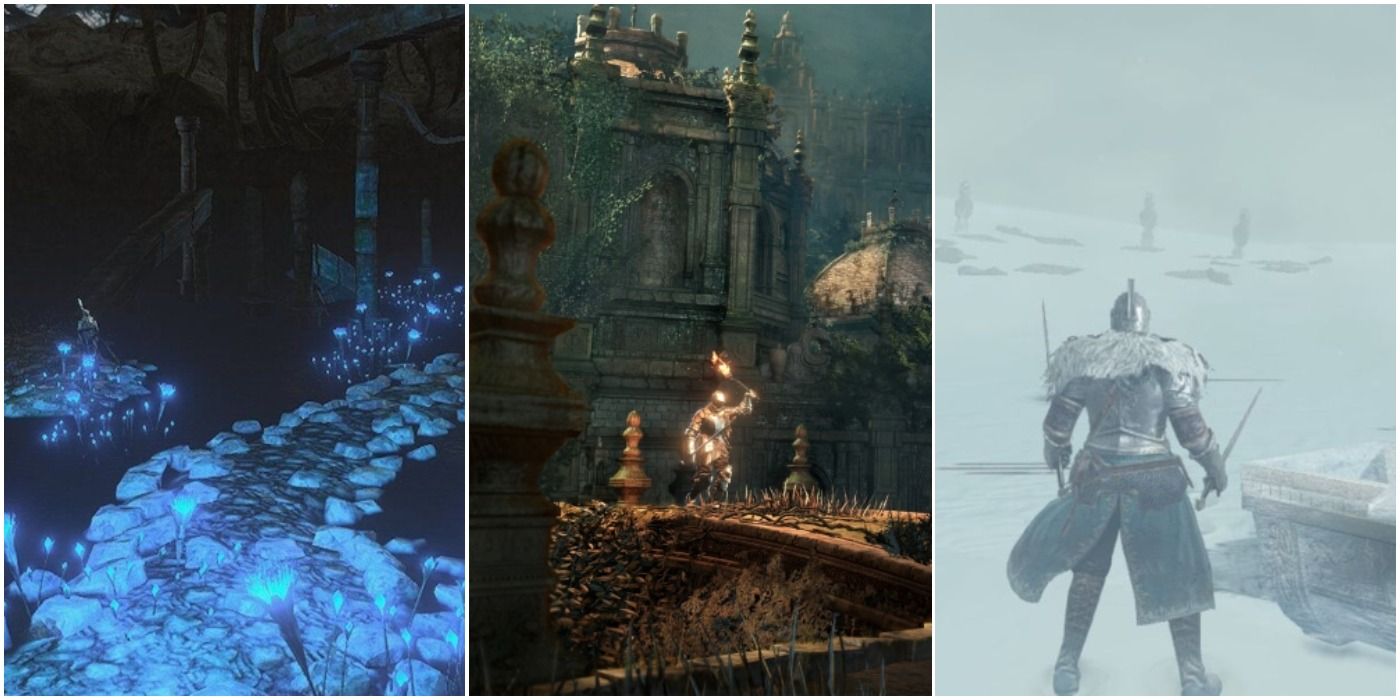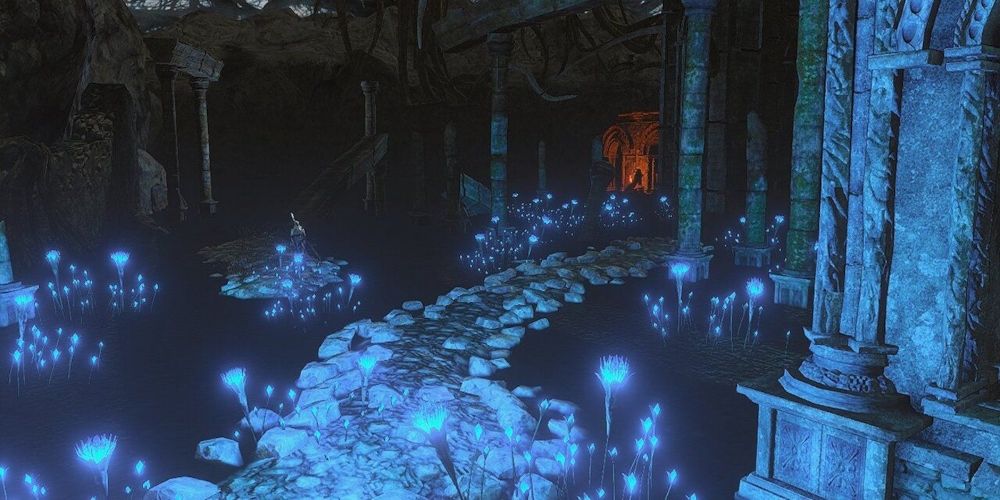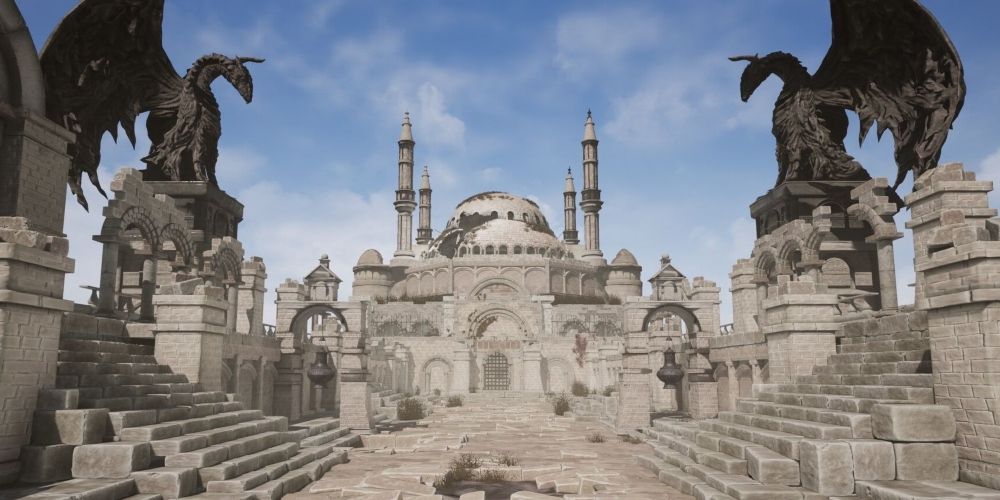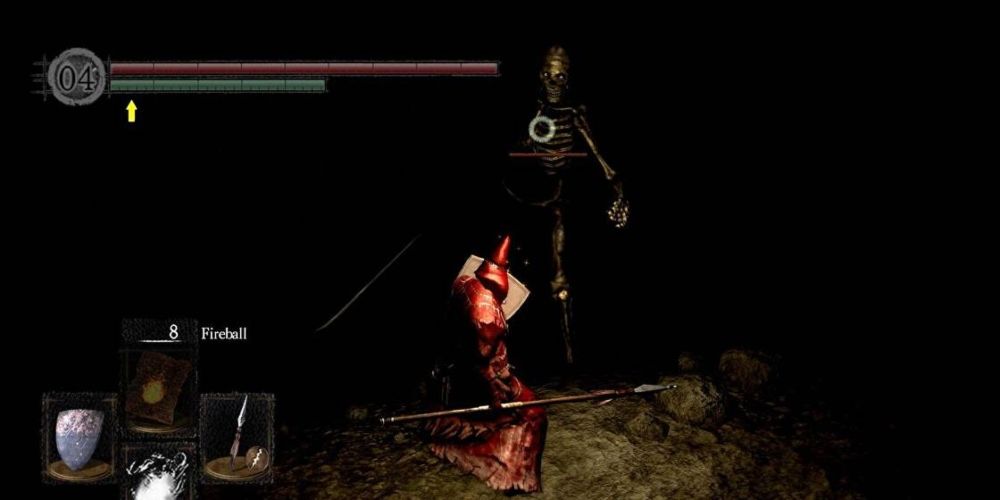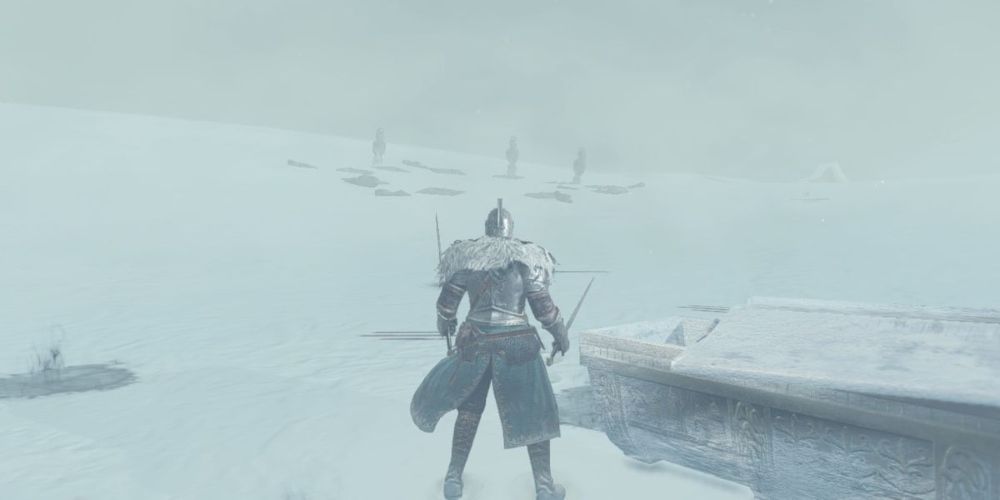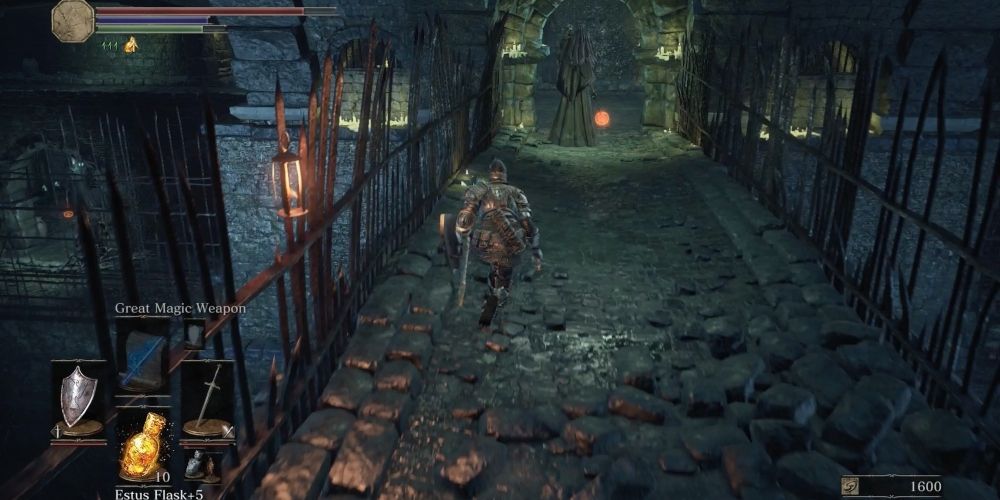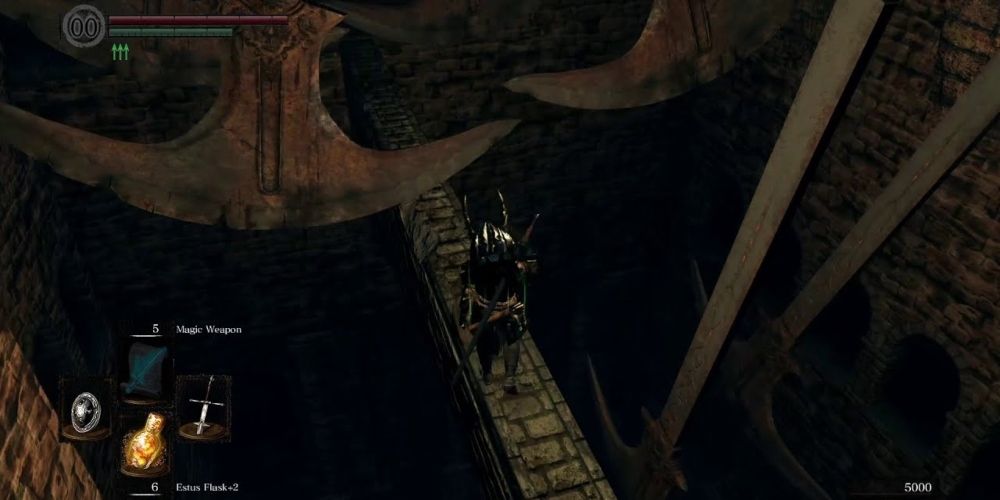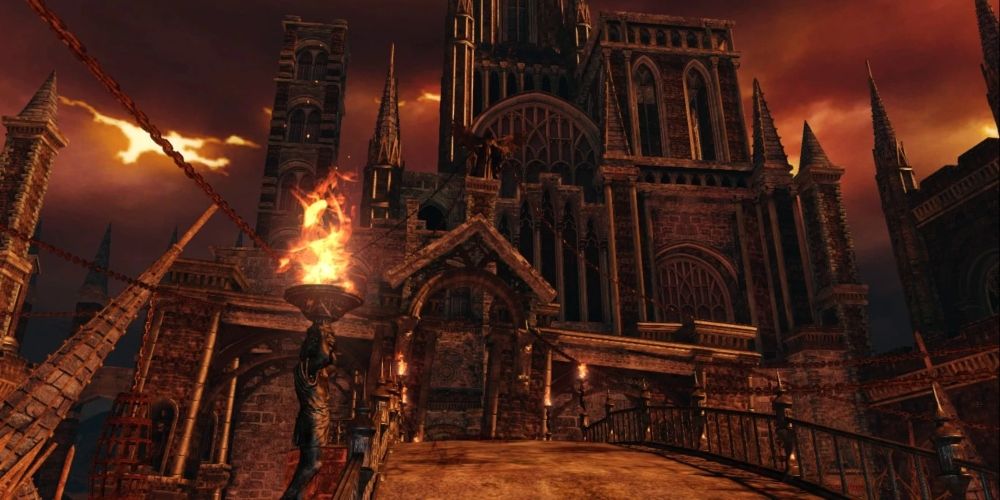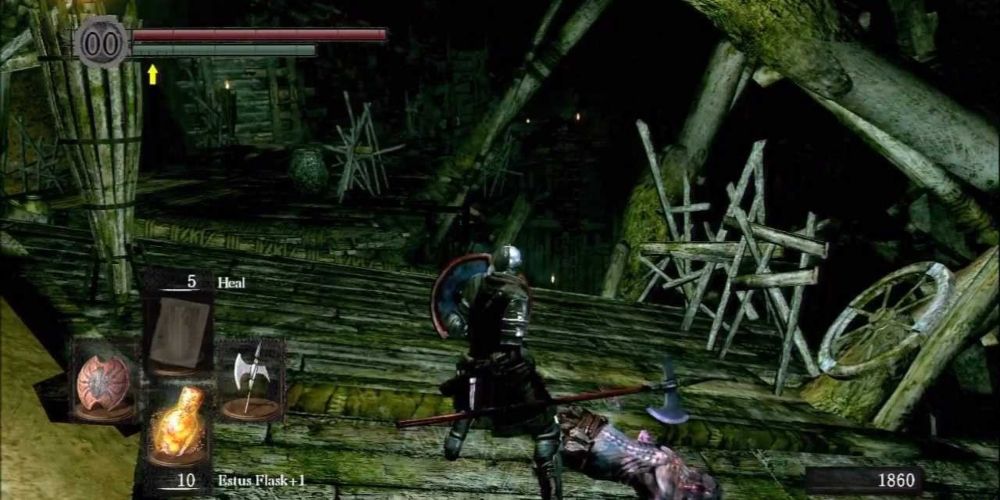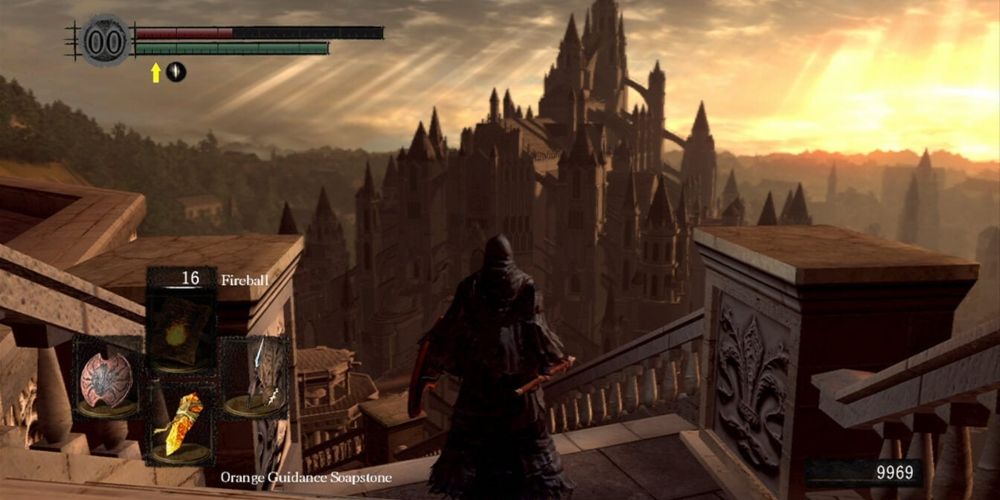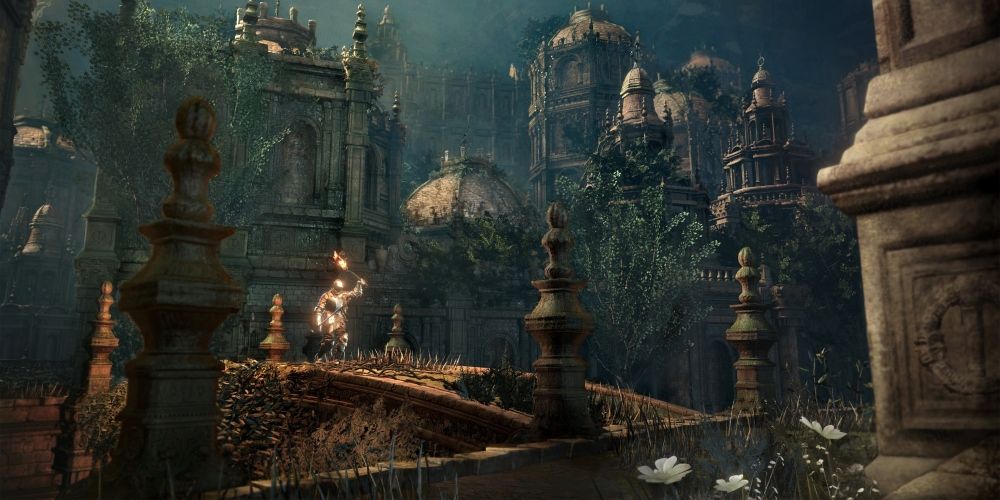The Dark Souls trilogy is infamous and beloved for its high level of difficulty. The player faces intense challenges that the game lets them figure their own way around or through. With its precise, strenuous melee combat, its lack of clear instructions and its penalties for failure, there is a lot going against the player.
While many focus on the game's boss fights, the bulk of the game isn't much easier. Most bosses are at the end of challenging areas full of traps, vicious enemies, and confusing layouts. While most areas tend to be difficult, there are those that have become infamous for how challenging they are. To this day, they're feared by Dark Souls players.
10 The Shrine Of Amana Used To Be Much Worse, But It's Still A Challenge
One area of Dark Souls II that rapidly became infamous is the Shrine of Amana. A dark and dank watery environment, the challenge of the Shrine came from its overwhelming array of threats. From almost the off, players were bombarded by long-range spells from enemies they couldn't even see. Attempting to sneak around often saw the player fall off nearly-invisible ledges in the water.
The level's infamy was such that it saw an overhaul in the Scholar of the First Sin version of the game, which had balance as a major focus. Nowadays, it's a far less punishing grind, but its number of ranged enemies and ease of falling off the man mean players still can't take it lightly.
9 Archdragon Peak Is Beautiful And Deadly
Archdragon Peak is a hidden area in Dark Souls III that has to be unlocked using a gesture gained in an optional area next to a statue on the other side of the game's world. For their efforts, the player is rewarded with beautiful architecture, a pleasant environment, plenty of loot, and a number of terrifying foes.
The area isn't unfair, but many players struggle against its Serpent-Man enemies, who hit hard and have an eye-watering number of hit points. Ultimately, the area is challenging – not for any gimmicks or unique elements but for being full of tough but fair enemies. As such, it's one of the most popular areas in the game.
8 The Tomb Of The Giants Is Pitch-Black And Precipitous
Something sure to raise fan ire in Dark Souls are areas where visibility is limited. The late-game Tomb of the Giants is one such area. Unlocked after defeating Pinwheel in the Catacombs, the player has to go there to defeat the Gravelord Nito and claim his Lord Soul. Like the Catacombs, it's confusingly laid out and full of hostile skeletons, and unlike them, it's pitch-dark.
There's hardly any light at all in the area unless the player brings it themselves, and the result is a nightmarish landscape of hidden enemies and narrow ledges, all of which are difficult to navigate. Ultimately, the few ways of providing consistent light without a torch, such as the Sunlight Maggot or the Cast Light spell, are almost required to explore the place.
7 Frigid Outskirts Is Challenging In The Wrong Ways
One of the least popular areas in Dark Souls II is the Frigid Outskirts from the Crown of the Ivory King DLC. It seems initially simple, even uninspired, as a wide, largely flat plane containing a bonfire and a boss arena. However, the challenge appears quickly as a blizzard strikes.
The blizzard reduces visibility to almost zero without any way of clearing it. The player has to pick their way through an unremarkable landscape, hoping to stumble upon the correct route, all while being ambushed by giant reindeer who can see fine in the snow. The area is considered one of the series' worst for its unfair challenge.
6 Irrithyl Dungeon Is Full Of Nightmarish Foes
The cold valley city of Irrithyl is widely-considered a challenging but rewarding area of Dark Souls III. It's well-liked by fans for its challenge and aesthetic. However, underneath and mandatory to complete en route to the Profane Capital, is the Irrithyl Dungeon. This area is less well-liked and feared by those who've experienced it.
Aside from being dark, tense, and twisty, it also has one of the most hated enemies in the game: Jailers. These enemies are unique in that they don't just hurt the player by looking at them, they reduce their maximum health. This is almost unheard of in the games, and enough to make players rightfully wary of the region.
5 Sen's Fortress Is A Deliberately Grueling Test
After the Chosen Undead rings the Bells of Awakening in both Blighttown and the Undead Parish, the entrance to Sen's Fortress rumbles open. A test to ensure the Chosen Undead is capable of facing the challenges ahead of them, the fortress has a well-earned infamous reputation amongst fans.
It can be hard to navigate, has its second bonfire very well-hidden, and its enemies tend to be tough and very hard to stagger, but it's most feared for its traps. Featuring spikes, arrows, axes, murderous elevators, and mimics, almost nowhere in the fortress is safe, which creates a tense and challenging environment.
4 Iron Keep Has Hard Enemies And A Challenging Boss
Lava is often a sign of a challenging area in the Dark Souls games, and the Iron Keep of Dark Souls II is no exception. A castle bit over an enormous pit of magma, the area is full of traps, narrow walkways, and challenging enemies that hit hard and can take plenty of punishment.
With loot to bait players near fire and magma, ambushes, and the lengthy range at which enemies turn aggressive, Iron Keep is considered a distinct challenge by players. In addition, while its main boss, the Old Iron King, is considered a pushover, it also contains the optional Smelter Demon – something most players fear far more.
3 Blighttown Has Everything Players Hate
One of the most infamous regions of the first Dark Souls is the notoriously unpleasant Blighttown. Poison swamps and areas that slow players down whilst inflicting damaging status effects are one of the least-liked design elements of the series. Blighttown is the archetypal one with much of its ground surface being slow and unsafe, making combat unpleasant.
Blighttown has plenty of other challenging elements; however, its first section consists primarily of narrow walkways over lethal falls crowded with challenging enemies, and it even includes the hated 'Toxic' status effect. Furthermore, on certain consoles, the area also causes performance issues, unfairly compounding its challenge.
2 Anor Londo Has Its Infamous Archers
The ultimate goal of the first half of Dark Souls is for the player to fight their way to and through Anor Londo: the city of the gods. Reaching it involves fighting through the decayed Undead Burg, the hated Blighttown, and the terrifying Sen's Fortress. Once there, the player sees a beautiful and shining city, and one even harder than what has come before.
All the areas' enemies are tough, well-designed, and lethal, but none are more renowned than the Silver Knight Archers. Firing huge arrows that knock players several feet, they're carefully spaced around the narrowest parts of the city, making infamously challenging encounters. Nonetheless, the area is one of the most popular in Dark Souls and considered iconic for the series.
1 The Ringed City Is One Final Challenge
The Ringed City isn't just the final piece of DLC for Dark Souls III, it's the final piece of content for the entire Dark Souls franchise with director Hidetaka Miyazaki moving on to Sekiro: Shadows Die Twice and Elden Ring. As such, the DLC is a farewell letter to fans of the series, and its namesake area is a fitting challenge.
The Ringed City is huge and full of danger. Its common Ringed Knight enemies are infamous for hitting hard, moving fast, having lengthy combos that spell death, and generally setting the standard. In addition, it has several segments designed to force the player on the back foot, such as enormous angels forcing the player to sneak around and an army of archers they have to take cover from, ensuring an epic final challenge.

